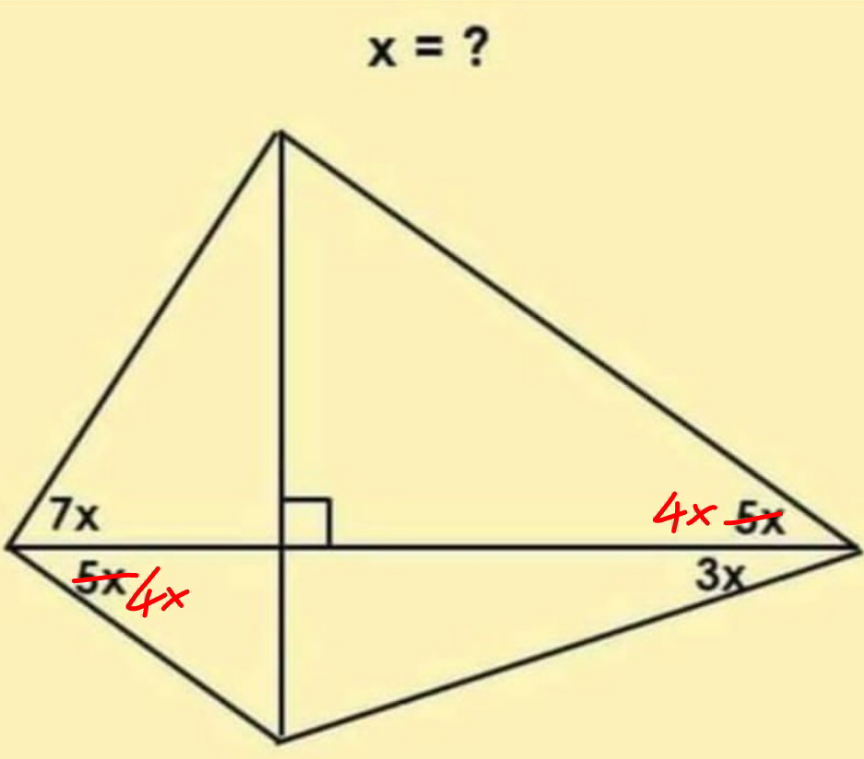
Question Number 165170 by Tawa11 last updated on 26/Jan/22
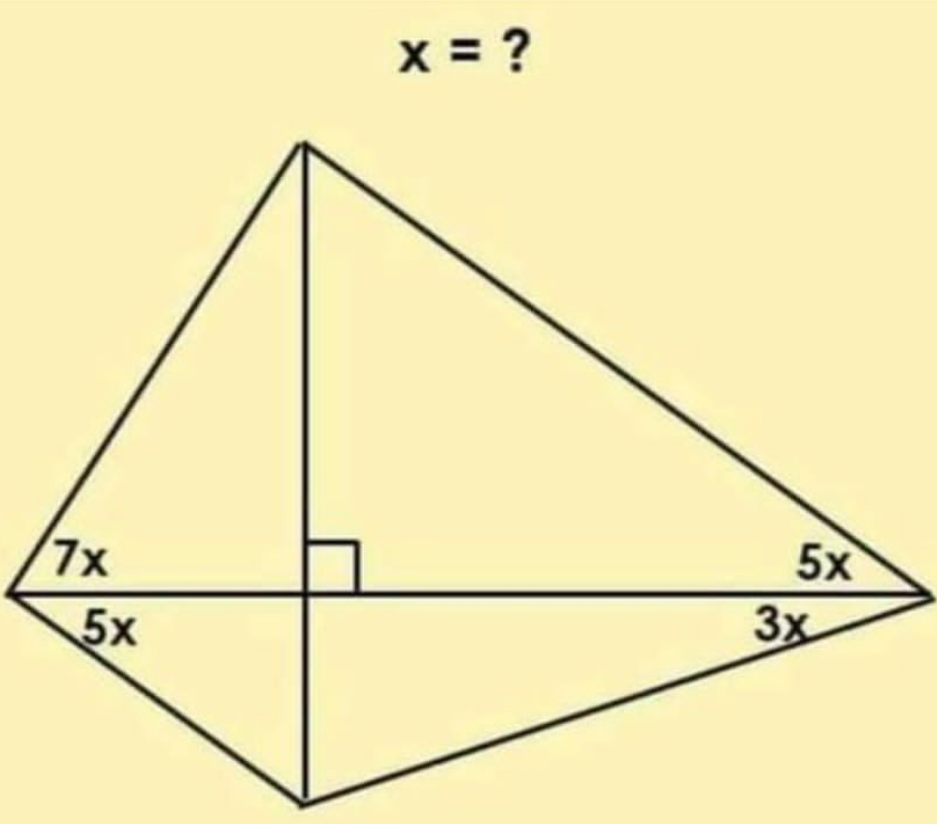
Commented by mr W last updated on 27/Jan/22
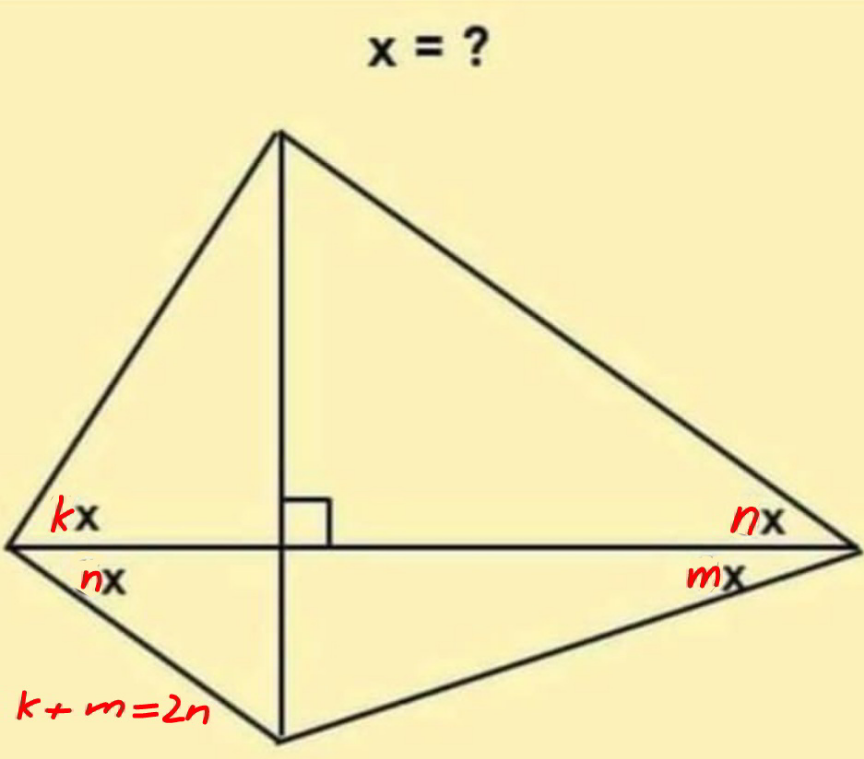
Commented by mr W last updated on 27/Jan/22

$${generally}: \\ $$$${if}\:{k}+{m}=\mathrm{2}{n},\:{then} \\ $$$${x}=\frac{\mathrm{45}°}{{n}} \\ $$
Commented by Tawa11 last updated on 27/Jan/22

$$\mathrm{I}\:\mathrm{appreciate}\:\mathrm{sir}. \\ $$
Answered by aleks041103 last updated on 27/Jan/22
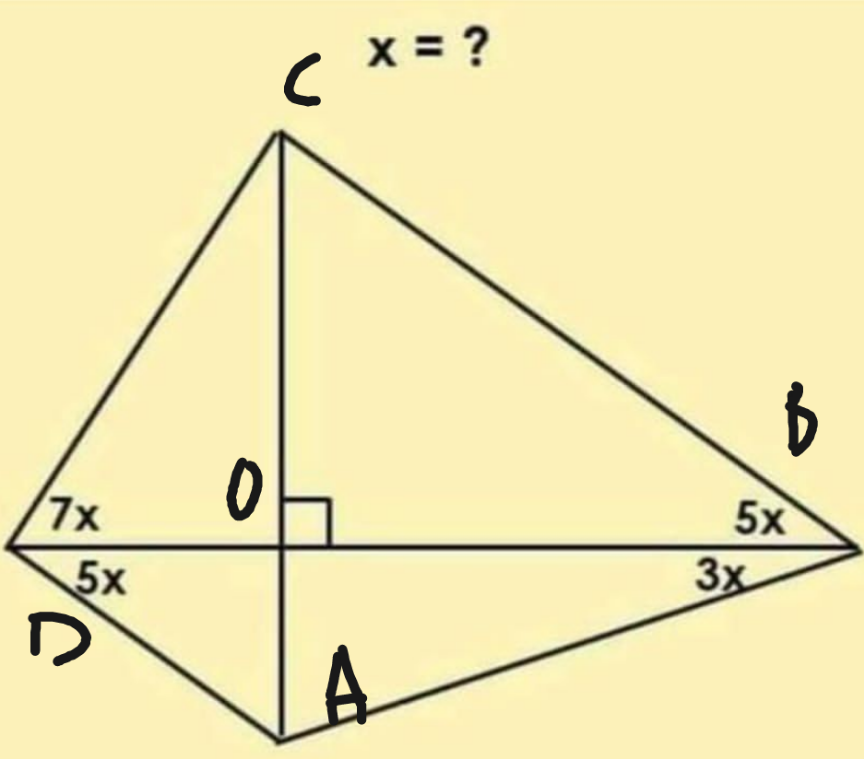
Commented by aleks041103 last updated on 27/Jan/22
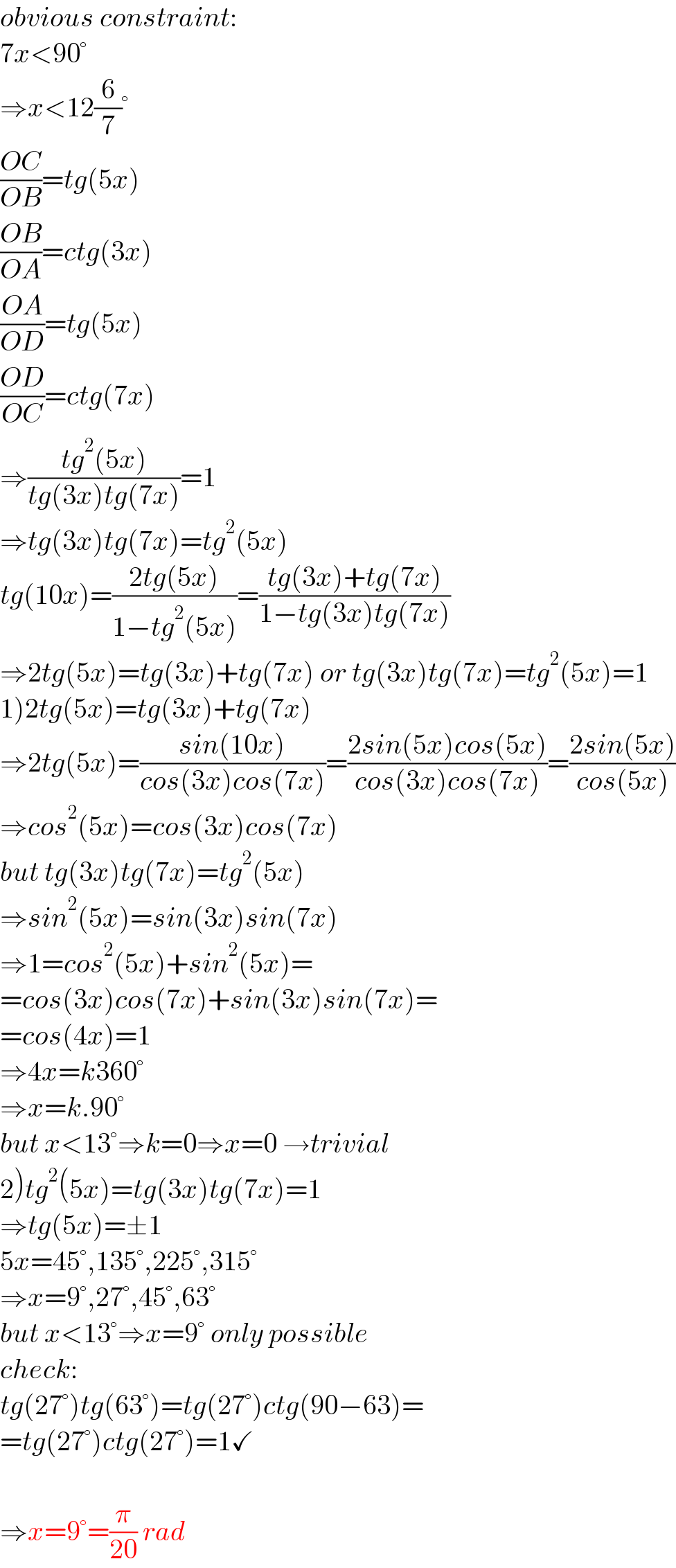
$${obvious}\:{constraint}: \\ $$$$\mathrm{7}{x}<\mathrm{90}° \\ $$$$\Rightarrow{x}<\mathrm{12}\frac{\mathrm{6}}{\mathrm{7}}° \\ $$$$\frac{{OC}}{{OB}}={tg}\left(\mathrm{5}{x}\right) \\ $$$$\frac{{OB}}{{OA}}={ctg}\left(\mathrm{3}{x}\right) \\ $$$$\frac{{OA}}{{OD}}={tg}\left(\mathrm{5}{x}\right) \\ $$$$\frac{{OD}}{{OC}}={ctg}\left(\mathrm{7}{x}\right) \\ $$$$\Rightarrow\frac{{tg}^{\mathrm{2}} \left(\mathrm{5}{x}\right)}{{tg}\left(\mathrm{3}{x}\right){tg}\left(\mathrm{7}{x}\right)}=\mathrm{1} \\ $$$$\Rightarrow{tg}\left(\mathrm{3}{x}\right){tg}\left(\mathrm{7}{x}\right)={tg}^{\mathrm{2}} \left(\mathrm{5}{x}\right) \\ $$$${tg}\left(\mathrm{10}{x}\right)=\frac{\mathrm{2}{tg}\left(\mathrm{5}{x}\right)}{\mathrm{1}−{tg}^{\mathrm{2}} \left(\mathrm{5}{x}\right)}=\frac{{tg}\left(\mathrm{3}{x}\right)+{tg}\left(\mathrm{7}{x}\right)}{\mathrm{1}−{tg}\left(\mathrm{3}{x}\right){tg}\left(\mathrm{7}{x}\right)} \\ $$$$\Rightarrow\mathrm{2}{tg}\left(\mathrm{5}{x}\right)={tg}\left(\mathrm{3}{x}\right)+{tg}\left(\mathrm{7}{x}\right)\:{or}\:{tg}\left(\mathrm{3}{x}\right){tg}\left(\mathrm{7}{x}\right)={tg}^{\mathrm{2}} \left(\mathrm{5}{x}\right)=\mathrm{1} \\ $$$$\left.\mathrm{1}\right)\mathrm{2}{tg}\left(\mathrm{5}{x}\right)={tg}\left(\mathrm{3}{x}\right)+{tg}\left(\mathrm{7}{x}\right) \\ $$$$\Rightarrow\mathrm{2}{tg}\left(\mathrm{5}{x}\right)=\frac{{sin}\left(\mathrm{10}{x}\right)}{{cos}\left(\mathrm{3}{x}\right){cos}\left(\mathrm{7}{x}\right)}=\frac{\mathrm{2}{sin}\left(\mathrm{5}{x}\right){cos}\left(\mathrm{5}{x}\right)}{{cos}\left(\mathrm{3}{x}\right){cos}\left(\mathrm{7}{x}\right)}=\frac{\mathrm{2}{sin}\left(\mathrm{5}{x}\right)}{{cos}\left(\mathrm{5}{x}\right)} \\ $$$$\Rightarrow{cos}^{\mathrm{2}} \left(\mathrm{5}{x}\right)={cos}\left(\mathrm{3}{x}\right){cos}\left(\mathrm{7}{x}\right) \\ $$$${but}\:{tg}\left(\mathrm{3}{x}\right){tg}\left(\mathrm{7}{x}\right)={tg}^{\mathrm{2}} \left(\mathrm{5}{x}\right) \\ $$$$\Rightarrow{sin}^{\mathrm{2}} \left(\mathrm{5}{x}\right)={sin}\left(\mathrm{3}{x}\right){sin}\left(\mathrm{7}{x}\right) \\ $$$$\Rightarrow\mathrm{1}={cos}^{\mathrm{2}} \left(\mathrm{5}{x}\right)+{sin}^{\mathrm{2}} \left(\mathrm{5}{x}\right)= \\ $$$$={cos}\left(\mathrm{3}{x}\right){cos}\left(\mathrm{7}{x}\right)+{sin}\left(\mathrm{3}{x}\right){sin}\left(\mathrm{7}{x}\right)= \\ $$$$={cos}\left(\mathrm{4}{x}\right)=\mathrm{1} \\ $$$$\Rightarrow\mathrm{4}{x}={k}\mathrm{360}° \\ $$$$\Rightarrow{x}={k}.\mathrm{90}° \\ $$$${but}\:{x}<\mathrm{13}°\Rightarrow{k}=\mathrm{0}\Rightarrow{x}=\mathrm{0}\:\rightarrow{trivial} \\ $$$$\left.\mathrm{2}\right){tg}^{\mathrm{2}} \left(\mathrm{5}{x}\right)={tg}\left(\mathrm{3}{x}\right){tg}\left(\mathrm{7}{x}\right)=\mathrm{1} \\ $$$$\Rightarrow{tg}\left(\mathrm{5}{x}\right)=\pm\mathrm{1} \\ $$$$\mathrm{5}{x}=\mathrm{45}°,\mathrm{135}°,\mathrm{225}°,\mathrm{315}° \\ $$$$\Rightarrow{x}=\mathrm{9}°,\mathrm{27}°,\mathrm{45}°,\mathrm{63}° \\ $$$${but}\:{x}<\mathrm{13}°\Rightarrow{x}=\mathrm{9}°\:{only}\:{possible} \\ $$$${check}: \\ $$$${tg}\left(\mathrm{27}°\right){tg}\left(\mathrm{63}°\right)={tg}\left(\mathrm{27}°\right){ctg}\left(\mathrm{90}−\mathrm{63}\right)= \\ $$$$={tg}\left(\mathrm{27}°\right){ctg}\left(\mathrm{27}°\right)=\mathrm{1}\checkmark \\ $$$$ \\ $$$$\Rightarrow{x}=\mathrm{9}°=\frac{\pi}{\mathrm{20}}\:{rad} \\ $$
Commented by Tawa11 last updated on 27/Jan/22

$$\mathrm{I}\:\mathrm{appreciate}\:\mathrm{sir} \\ $$
Answered by nurtani last updated on 27/Jan/22

$$\mathrm{7}{x}+\mathrm{5}{x}+\mathrm{5}{x}+\mathrm{3}{x}\:=\:\mathrm{180}° \\ $$$$\mathrm{20}{x}\:=\:\mathrm{180}° \\ $$$$\:\:\:\:\:{x}\:=\:\frac{\mathrm{180}°}{\mathrm{20}}\:=\:\mathrm{9}° \\ $$
Commented by mr W last updated on 27/Jan/22

$${i}\:{think}\:{it}'{s}\:{just}\:{by}\:{accident}\:{true}.\: \\ $$$${the}\:{method}\:{can}'{t}\:{be}\:{generally}\:{applied}, \\ $$$${for}\:{example}\:{in}\:{following}\:{case}: \\ $$
Commented by mr W last updated on 27/Jan/22
